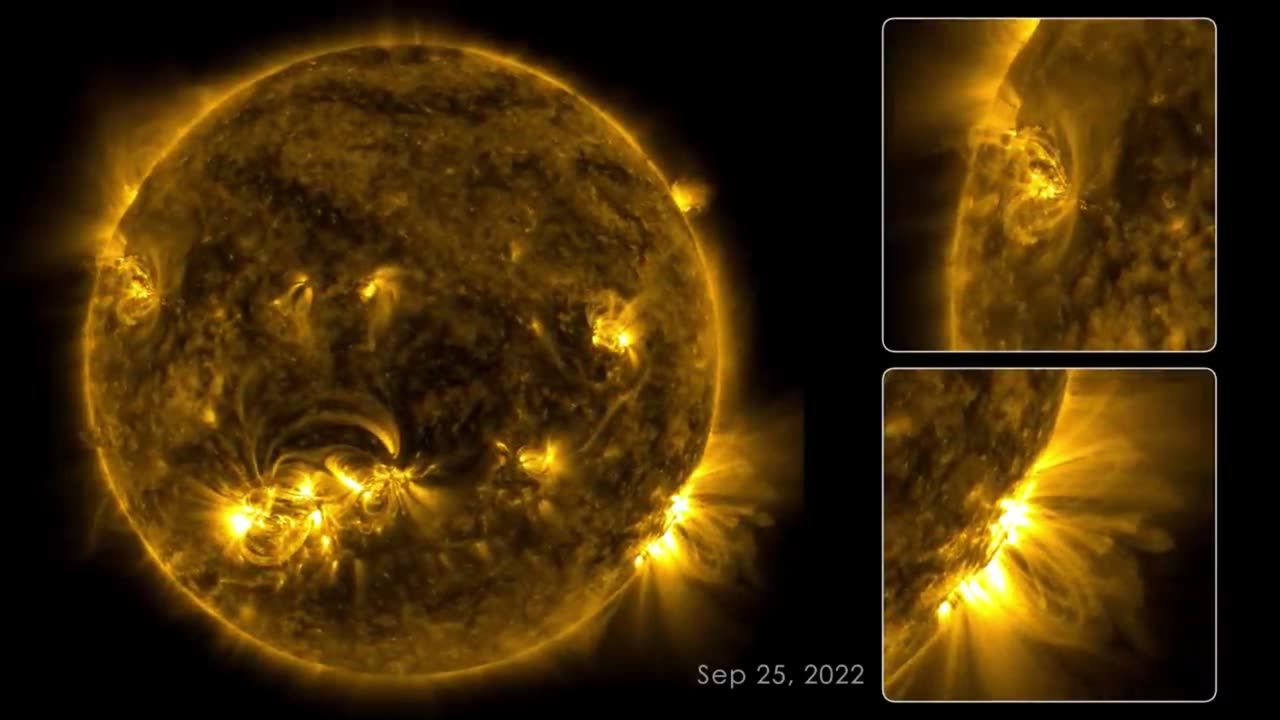Premium Only Content

Solar Odyssey: Unveiling the Marvels of 133 Days on the Sun
On the left side of the frame is the full circle of the Sun. It appears in a golden yellow color, but splotchy and with thin yellow wisps extending from the surface. Some areas are very bright and others almost black. The whole Sun rotates steadily, with one full rotation taking 12 minutes in this time lapse. There are usually only a few bright regions visible at a time and they shift and flash like small fires. From these regions there are wispy loops reaching up above the surface that rapidly change shape and size.
On the right side of the frame are two white-outlined squares with enlargements of interesting regions of the Sun.
This video chronicles solar activity from Aug. 12 to Dec. 22, 2022, as captured by NASA’s Solar Dynamics Observatory (SDO). From its orbit in space around Earth, SDO has steadily imaged the Sun in 4K x 4K resolution for nearly 13 years. This information has enabled countless new discoveries about the workings of our closest star and how it influences the solar system.
With a triad of instruments, SDO captures an image of the Sun every 0.75 seconds. The Atmospheric Imaging Assembly (AIA) instrument alone captures images every 12 seconds at 10 different wavelengths of light. This 133-day time lapse showcases photos taken at a wavelength of 17.1 nanometers, which is an extreme-ultraviolet wavelength that shows the Sun’s outermost atmospheric layer: the corona. Compiling images taken 108 seconds apart, the movie condenses 133 days, or about four months, of solar observations into 59 minutes. The video shows bright active regions passing across the face of the Sun as it rotates. The Sun rotates approximately once every 27 days. The loops extending above the bright regions are magnetic fields that have trapped hot, glowing plasma. These bright regions are also the source of solar flares, which appear as bright flashes as magnetic fields snap together in a process called magnetic reconnection.
While SDO has kept an unblinking eye pointed toward the Sun, there have been a few moments it missed. Some of the dark frames in the video are caused by Earth or the Moon eclipsing SDO as they pass between the spacecraft and the Sun. Other blackouts are caused by instrumentation being down or data errors. SDO transmits 1.4 terabytes of data to the ground every day. The images where the Sun is off-center were observed when SDO was calibrating its instruments.
SDO and other NASA missions will continue to watch our Sun in the years to come, providing further insights about our place in space and information to keep our astronauts and assets safe.
-
 LIVE
LIVE
GritsGG
2 hours ago#1 Most Warzone Wins 4000+!
110 watching -
 41:54
41:54
Nicholas Bowling
3 hours agoWhile Preaching to Muslims, EX-MUSLIM Shares Why He Left Islam (London, UK)
39 -
 LIVE
LIVE
bucketofish
1 hour agoNoise Floor \\ Behind the Mix - Ep 002 - Wide Awake by Katy Perry
38 watching -
 LIVE
LIVE
Biscotti-B23
1 hour ago🔴 LIVE DISPATCH PLAYTHROUGH & PARTY GAMES
226 watching -
 LIVE
LIVE
Lofi Girl
2 years agoSynthwave Radio 🌌 - beats to chill/game to
90 watching -
 LIVE
LIVE
LumpyPotatoX2
3 hours agoHostile Takeover | High-Stakes PvP - #RumbleGaming
142 watching -
 2:07:50
2:07:50
LadyDesireeMusic
3 hours ago $17.77 earnedCooking Stream | Make Ladies Great Again
45.4K5 -
 2:03:42
2:03:42
The Connect: With Johnny Mitchell
1 day ago $27.90 earnedAmerican Vigilante Reveals How He Went To WAR Against The WORST Cartels In Mexico
118K13 -
 LIVE
LIVE
a12cat34dog
4 hours agoONE OF THE BEST REMAKES EVER :: Resident Evil 4 (2023) :: I GOT 100% ON EVERYTHING {18+}
98 watching -
 19:31
19:31
Liberty Hangout
3 days agoAnti-Trumpers Repeat CNN Talking Points
209K251